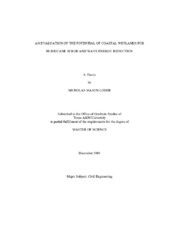| dc.description.abstract | Given the past history and future risk of storm surge in the United States,
alternative storm protection techniques are needed to protect vital sectors of the
economy and population, particularly within southeastern Louisiana. It is widely
hypothesized that coastal wetlands offer protection from storm surge and wave action,
though the extent of this protection is unknown due to the complex physics behind
vegetated flow dynamics. This thesis presents numerical modeling results that estimate
the relative sensitivity of waves and storm surge to characteristics embodied by coastal
wetlands. An idealized grid domain and 400 km2 (20 km by 20 km) marsh feature
provide a controlled environment for evaluating marsh characteristics, including bottom
friction, elevation, and continuity. Marsh continuity is defined as the ratio of healthy
marsh area to open water area within the total wetland area.
It is determined that increased bottom friction reduces storm surge levels and
wave heights. Through the roughening of the bottom from sandy to covered with tall
grass, it is estimated that waves may be dampened by up to 1.2 m at the coast, and peak
surge may be reduced by as much as 35%. The lowering of marsh elevation generally increases wave heights and decreases surge levels, as expected. A 3.5 m decrease in
marsh elevation results in as much as a 2.6 m increase in wave height, and up to a 15%
decrease in surge levels. Reductions in marsh continuity enhance surge conveyance into
and out of the marsh. For storms of low surge potential, surge is increased by as much
as 70% at the coast due to decreasing marsh continuity from 100% to 50%, while for
storms of high surge potential, surge is decreased by 5%. This indicates that for storms
of high surge potential, a segmented marsh may offer comparable surge protection to
that of a continuous marsh. Wave heights are generally increased within the marsh due
to the transmission of wave energy through marsh channels. Results presented in this
thesis may assist in the justification of coastal wetland mitigation, and optimize marsh
restoration in terms of providing maximum storm protection. | en |


